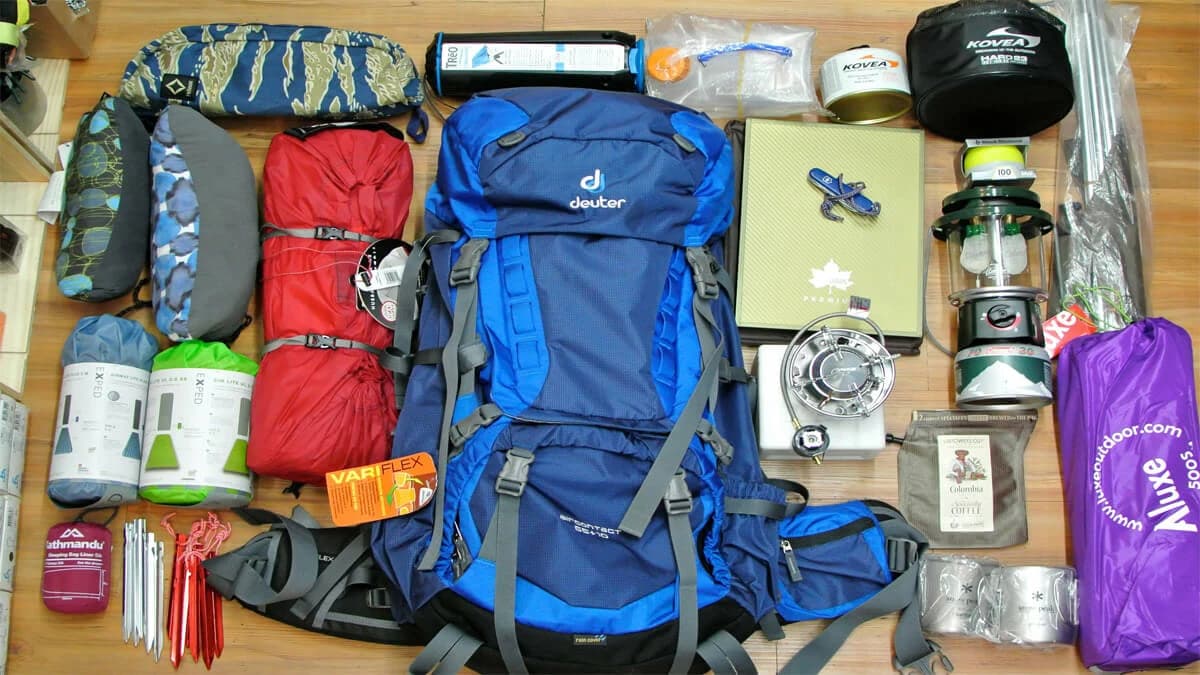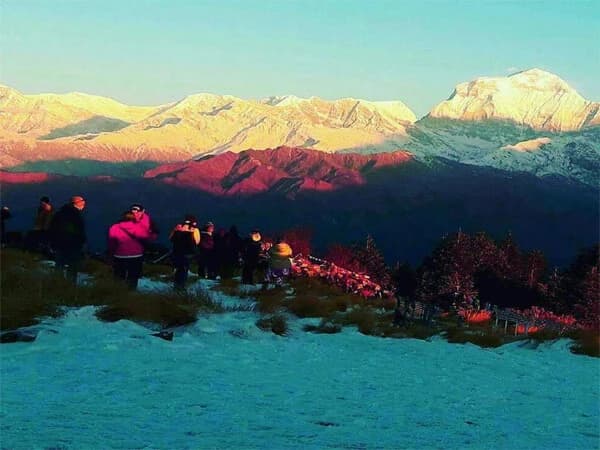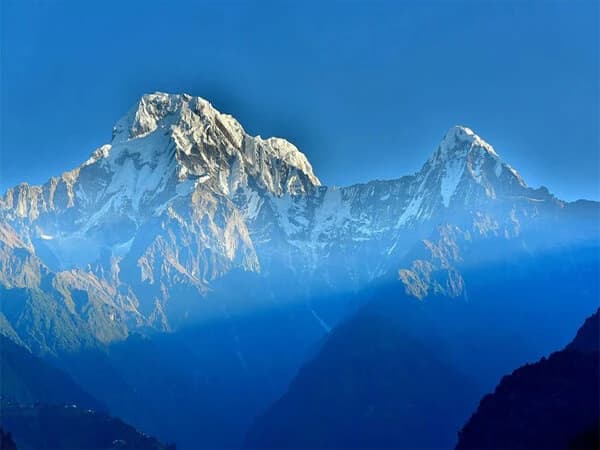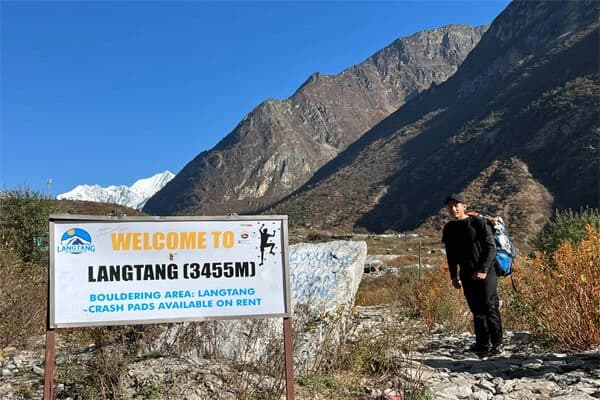The proper equipment is necessary for trekking in Nepal in order to keep warm, safe, and comfortable. Packing wisely is important whether you are embarking on a short hike or a long high-altitude trek. You should know how to pack lightly yet smartly and how to decide between buying or renting. Depending on the route and season, our company, Nepal Trekking Routes can help beginner and experienced trekkers. Having the right equipment results in a fun and hassle-free trek.
Trekking Equipment: List of trekking gear
Are you preparing for Trekking in Himalaya? The right trekking equipment can make all the difference. Essential trekking gear including hiking boots a water resistant backpack, moisture, wicking clothing and reliable sleeping bag. Trekking poles and water purification system play vital role for stability and hydration. A medical kit flashlight and multi tool are vital for safety while layered clothing helps you adopt to changing weather conditions. Investing in quality trekking gear ensures fomfort safety and unforgettable adventure. Do you need and advice from expert for best trekking equipmen? please reach out us.
Trekking in Nepal is one of the most thrilling experiences you can have. You can breathe the fresh air, stroll through the stunning scenery, and develop a strong bond with the natural world. Trekking offers you the opportunity to see the world peacefully. You will cross rivers, hike mountain paths, and stroll through the deep forests. To fully appreciate this experience, you must be ready with appropriate trekking equipment.
Your trek will be more pleasant, safe, and comfortable if you bring the right gear. But your trip could soon become a chore if you forget something essential, like a first aid kit, rain cover, or warm jacket. Some of the trekkers lack proper planning. At high elevations, people get sunburned because they fail to wear sunscreen. Others who fail to pack appropriate footwear develop blisters within a single day. Some people struggle through chilly evenings if they don’t bring enough clothing. On the trail, these minor errors can have a significant impact.
Trekking is not a walk in the park. Particularly in the mountains, the weather might change abruptly. It can be sunny one minute and raining or snowing the next. After the sun goes down, temperatures can rapidly drop. For this reason, it is crucial to have waterproof gear, sturdy shoes, and layers of clothing with you. Your equipment list may vary slightly based on your destination, such as a high-altitude trek or a jungle safari in Nepal. However, the fundamental concept remains the same: pack little and only what you need.
The purpose of this blog is to help you with that. We have put together a simple and easy-to-follow list of trekking supplies. Whether you are going on a quick weekend hike or a multi-day trek in the Himalayas, this list will include everything you need. You might want to bring items, including clothing and shoes, to water bottles and headlamps.
We know that not everyone is a professional trekker. Perhaps you have hiked a few times and want to tackle a longer walk, or this is your first time. That is totally OK. Trekking is enjoyable without the need for pricey equipment or high-end brands. The most important thing is that your gear fits properly, is appropriate for the weather, and keeps you comfortable and safe.
Consider your trekking equipment as a travelling partner. It is there for you at every turn. Good gear provides you with the confidence to continue when the terrain becomes difficult. Additionally, it protects you from the cold and rain.
Therefore, spend some time reviewing this list before embarking on your adventure. Carrying the appropriate items is more important than carrying more. Let’s get started and make sure you are ready to enjoy your journey, no matter where it leads.
Trekking Clothing

Your clothing has more purposes than just keeping you warm when you are traveling into the mountains. They shield you from the sun, wind, rain, and snow. You can stay dry, comfortable, and even safe by dressing appropriately.
Here are the clothing layers:
Inner Layer
The first piece of clothing to come into contact with your skin is this one. Its function is to prevent perspiration from entering your body. You might quickly become cold if the sweat remains on your skin, especially at higher elevations. You can wear Merino wool or synthetic long-sleeved thermal tops and bottoms. Make sure you avoid clothing made of cotton. Cotton keeps you cold and retains moisture.
Middle Layer
By retaining body heat, this layer keeps you warm. Good options include padded synthetic jackets, down jackets, and fleece jackets. Down is lighter and warmer than synthetic materials, although it is less effective in damp conditions. Synthetic is heavier, but it performs better in damp environments.
Outer Layer
You are shielded from wind, rain, and snow by the outer layer. It must be both breathable and waterproof. You can wear a hooded waterproof jacket and waterproof trousers. GORE-TEX coats are fantastic but pricey. There are also plenty of affordable options.
Trekking shirts and trousers
Wear breathable, quick-drying clothing because you will be walking for hours. Long-sleeved shirts keep you warm in the shade and shield you from the sun. Trekking pants are comfortable, flexible, and lightweight. Convertible pants can be turned into shorts.
Socks and underwear
On a trek, even these little things count. The best socks are made of wool or synthetic materials. Keep three or four pairs on hand. Cotton socks are bad for blisters. For comfortable underwear, use materials that wick away moisture. Wear layers so you can alter your outfits when the weather does. It is the wisest strategy for maintaining comfort throughout the day.
Footwear
When trekking, your feet are your most vital tool. Selecting the appropriate footwear might determine whether a trek is fun or uncomfortable.
Trekking Boots
On uneven trails, trekking boots protect your feet and provide ankle support. Choose boots that are waterproof, high-ankle for support, and broken-in. Do not wear brand-new boots for long treks. Wearing your new boots on quick walks before your trek will help them break in.
Sandals or Camp Shoes
Taking off your boots is a wonderful feeling after a long day of walking. Sandals or camp shoes are useful in this situation. You can use them while exploring the teahouse or campsite, relaxing and allowing your feet to breathe. Crocs, flip-flops, or slip-on sandals are examples of lightweight footwear.
Optional Gaiters
Your lower pants and boot tops are covered by gaiters. They keep small rocks, mud, and snow out of your boots. It is beneficial in damp, snowy, or dusty conditions. It is not required for short hikes, but useful in wet or high-altitude environments. A quick advice is to wear thick socks with boots that fit properly. The last thing you want on a trek is blisters.
Accessories for Trekking
These minor details may not seem significant at first, but they have an impact on your comfort and safety during the trek.
Headgear and Hats
A hat with a wide brim shields your face and neck from the sun. During chilly mornings and evenings, a woolen cap or beanie will keep your head warm. You can wear a neck scarf or buff in a variety of ways, such as covering your head, face, or neck.
Gloves
In the mountains, your hands quickly become cold. Keep two pairs with you. Thin inner gloves for hiking or mild weather conditions. Thick, waterproof, and insulated outer gloves for colder climates.
Sunglasses
The sun is considerably more powerful at higher elevations. Ice and snow can cause eye strain because they reflect sunlight. Choose sunglasses that are UV-resistant, polarized, and wrap around for improved coverage. Even on short treks, always have these accessories with you. In the mountains, the weather can change rapidly.
Backpacking Essentials

It is really important what you carry and how you carry it. Your body experiences less stress when your bag is well-organized and allows you to move freely. The size of the backpack for a 1-3 day trek can be 20-30 liters. Whereas for treks lasting 4 or more days can be 50-70 liters. Choose a backpack that has a sturdy belt around the waist to support your back, several compartments, proper back ventilation, and shoulder cushioning.
Rain Cover
Make sure your bag has a rain cover at all times. It shields your equipment from snow and rain. Some backpacks have additional covers. If not, you can buy one separately. It is portable and lightweight.
Zip-lock plastic bags or dry bags
These help in keeping your belongings inside the bag organized and safe. You can use them for storing clothing, electronic devices, and records. It is useful for separating wet or filthy clothing. Don’t forget the necessities, but pack light. Before your trek, try everything on to see how it feels while walking.
Sleeping Gear
The secret to keeping strong during your walk is getting enough sleep. Occasionally, you need your sleeping gear even on teahouse treks, particularly in colder climates.
A sleeping Bag
It is essential to have a comfortable sleeping bag if you are trekking in cold or high-altitude environments. Check the temperature rating according to your routes and season to make sure it is rated for at least -10°C to -20°C. Mummy-style sleeping bags are lighter and warmer. A Down Sleeping bag is lighter and warmer, but it doesn’t work well in the rain. Whereas synthetic is heavier, but is better in a damp environment. Although some lodges provide blankets, it is safest to bring your own.
A mat or sleeping pad
This provides comfort and insulation beneath your sleeping bag. It is ideal for cold floors or camping treks. If you are staying at the teahouse with beds, it is not necessary.
An inflatable pillow or pillowcase
Many trekkers like a little inflatable pillow or pillowcase, but you may construct your own by rolling up your clothes. You may need one because teahouse pillows are not comfortable or hygienic. To keep your sleeping bag dry and warm, store it in a dry bag.
Hydration and Nutrition
Drink plenty of water for your health when walking in the mountains. Every day, you will spend hours walking, mostly in dry or high-altitude environments. Drinking too little water can make you feel drained or ill more quickly.
Hydration bladders or reusable water bottles
Bring a hydration bladder or a reusable water bottle. A hydration bladder is a water pouch with a sipping tube that fits in your backpack. It is fantastic because you can drink water while walking without stopping.
Tablets or Filters for Water Purification
You won’t find safe drinking water in many trekking areas. Although you can fill your bottle with water from taps or streams, it is not safe to drink untreated water. Purification tablets, a UV sterilizer, or a water filter can be useful in this situation. They kill harmful bacteria to prevent illness.
Electrolyte Packets
These are tiny packets of powder that you combine with water. They help in replenishing the minerals and salts lost through sweating. Electrolytes help you to stay energized and can help you avoid headaches or cramping.
Snacks
Keep high-energy snacks on hand, such as bars of energy, trail mix with fruits and nuts, candy or chocolates, and instant noodles for teahouse trekking. You can maintain a consistent level of energy throughout the day by eating little snacks in between meals.
Toiletries and Personal Goods
Maintaining personal hygiene is important, even when you are in the middle of nowhere. Particularly on longer treks, it keeps you energized and healthy.
Lip balm and sunscreen
Even on cloudy days, the sun is stronger at higher elevations. To prevent sunburn, apply sunscreen to your hands, neck, and face. Lip balm with SPF will prevent dry and cracked lips.
Biodegradable soap or wet wipes
Showers might not always be available to you. At the end of the day, wet wipes make it easier to clean your body. If you intend to wash your clothes or yourself in nature, use biodegradable soap to preserve the cleanliness of water sources.
Toothpaste and toothbrush
Easy yet necessary. Don’t forget to put them in a tiny zip-lock bag. To minimize space, you can also pack toothpaste in travel-sized containers.
Hand sanitizer and toilet paper
Toilet paper may not be available at restrooms in remote locations. To keep it dry, bring your roll in a zip-lock bag. Before eating and after using the restroom, apply hand sanitizer.
Quick Dry Towel
These towels dry rapidly after use and are lightweight and thin. Usually, a medium-sized one is sufficient for drying off after a shower or rain.
Period Products (For Females)
Bring your preferred period items, such as tampons, pads, or a menstrual cup. Additionally, it is a good idea to include additional zip-lock bags so you can carry used items until you find a suitable way to dispose of them.
Additional useful toiletries are nail clippers, as long nails can get dirty quickly, a small mirror, tweezers for splinters, and a comb or hairbrush. To save weight and space, it is better to bring travel-sized things.
Medical supplies and First Aid

Although the mountains are stunning, they may be physically tough. It is possible to get cuts, blisters, or altitude sickness. You can avoid problems by keeping a small personal first aid kit on hand.
Individual Drugs
Bring enough medication for your entire journey, and a few additional days, if you take it regularly for conditions like blood pressure, allergies, etc. They should be kept in a waterproof bag.
Blister Care
If your boots are not broken in, blisters are common. Bring moleskin strips or Compeed pads to protect your feet. This will prevent their worsening.
Basic First Aid Supplies
Band-aids in various sizes, antiseptic lotion (such as Betadine), wipes with alcohol to clean wounds, tape and gauze for larger cuts, safety pins for repairs or slings, and small scissors.
Painkillers and Anti-inflammatory Tablets
Medications such as ibuprofen or paracetamol relieve fevers, headaches, and muscle soreness.
Altitude Sickness Medicine
Altitude sickness is a serious concern while trekking above 3,000 meters, such as in the Annapurna or Everest regions. Consult a physician about Diamox or other preventive drugs. Only take it as required.
Rehydration Salts
If you have diarrhea or feel weak from dehydration, these can help. Keep in mind that this kit doesn’t have to be fancy. All it needs to do is work.
Electronics and Documents
A few gadgets and important documents are necessary to be organized, protected, and to stay connected.
Headlamp with extra batteries
A flashlight is not nearly as good as a headlamp. You can wear it at night when you are walking or working. Keep spare batteries with you at all times, especially for longer treks.
Power Bank and Charging Cables
In mountain teahouses, power might be scarce, and charging is frequently expensive. If you want to keep your camera or phone charged for a few days, bring a power bank. Remember to bring cables and adapters.
GPS or a phone
The majority of trekkers communicate, take pictures, and use their smartphones for navigation. Before the trek, get offline maps like Maps.me or Gaia GPS. A separate GPS tracker could be useful in some areas.
Travel Insurance documents
Keep physical or digital copies of your travel insurance with you at all times. In case of emergency, be sure your insurance includes coverage for helicopter rescue and high-altitude treks.
Trekking Permits and IDs
In many areas, permissions such as the TIMS Card or ACAP/MCAP permits are required. You will require a photocopy or the original passport, 2-4 passport-size photos, and permit printouts in a zip-lock bag or plastic folder.
Electronics that are optional include a GoPro or a camera, a Kindle or an e-reader, and earphones with noise cancellation for better sleep. Always use dry bags or waterproof coverings to protect electronics from dampness and rain.
Useful but optional Items
Although they are not “must-haves”, these can significantly enhance your trekking experience, particularly on longer or difficult treks.
Trekking Poles:
On steep ascents or descents, trekking poles improve balance and lessen knee strain. These are useful for all ages and trail types. Select ones that are lightweight and adjustable.
Portable Journal or Book
In the mountains, evenings may be peaceful. Bring a journal and pen or a little book so you can pass the time and think back on your trek.
GoPro or a Camera
A lightweight camera or GoPro is a wonderful choice if you enjoy taking pictures or want to document your adventure. Don’t forget to include extra batteries and memory cards.
Safety pins and Duct tape
Blister patches, ripped clothing, and broken equipment can all be fixed with duct tape. In an emergency, safety pins are excellent for securing clothing together or repairing small pieces of equipment.
Small knife or Multitool
For tasks like cutting rope, opening parcels, or fixing equipment, a multitool such as a Swiss Army knife, can be useful.
Sleep mask and earplugs
Tents or shared teahouses can be noisy. A sleep mask filters early morning light, and earplugs improve your quality of sleep.
Whatever trekking equipment you use is the best. If you are excited or uncertain, it’s easy to overpack. Consider carefully what you need for your safety and comfort. Your journey will be enjoyable if you have the proper equipment and a packing plan.
Renting or Buying Trekking Equipment: Which one to choose?
One important question when organizing a trek in Nepal is whether to buy or rent trekking gear. The duration of your journey, how frequently you intend to trek, and your budget will all affect your decision.
If you want to trek only once or twice, renting is a wise choice. High-quality equipment, including sleeping bags, crampons, trekking poles, down jackets, and even backpacks, can be rented for reasonable daily prices in Kathmandu or Pokhara. Large products that you might not use again for a while can be rented to save money and space. However, rental equipment may occasionally be worn out or not fit properly, so always check its comfort and condition before starting a trek.
On the other hand, buying is preferable if you intend to travel frequently or require gear that fits your body well, such as trekking boots, base layers, or backpacks. Having your gear allows you to practice using it before your trek, which boosts your comfort and confidence.
You can buy long-term, personal necessities and rent large or rarely used products. Many trekkers combine both options. Trekking stores in Nepal make these choices simple and flexible. It all depends on your trekking goals and the amount of gear you wish to carry home.
Conclusion: Trekking Equipment
One of the most important things to do before starting your adventure is to pack the right trekking equipment. It keeps you secure, cozy, and prepared for any weather or challenge. Always keep in mind that you should only bring essentials. Always consider where you are going and the weather conditions. Our trekking agency, Nepal Trekking Routes, can offer you the best advice if you are not sure what to pack. We even provide some gear or help you with renting some equipment. Your walk will be more enjoyable and worry-free if you plan and have the proper gear.







